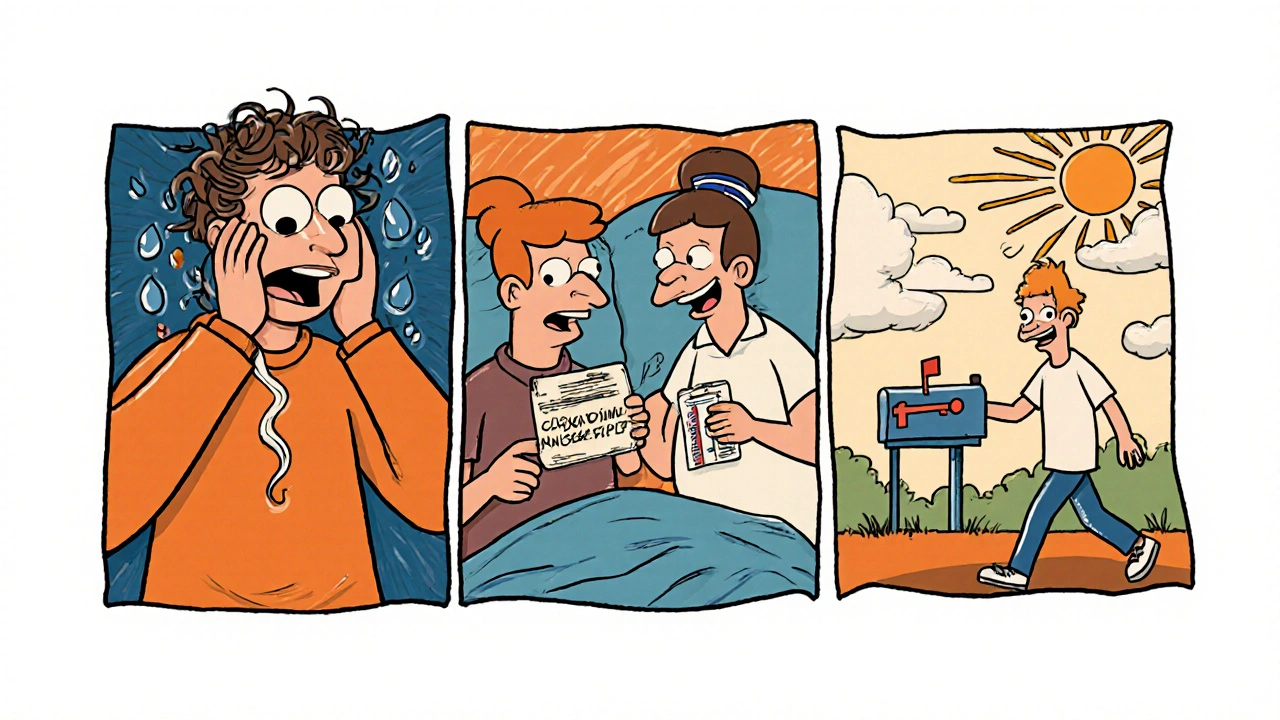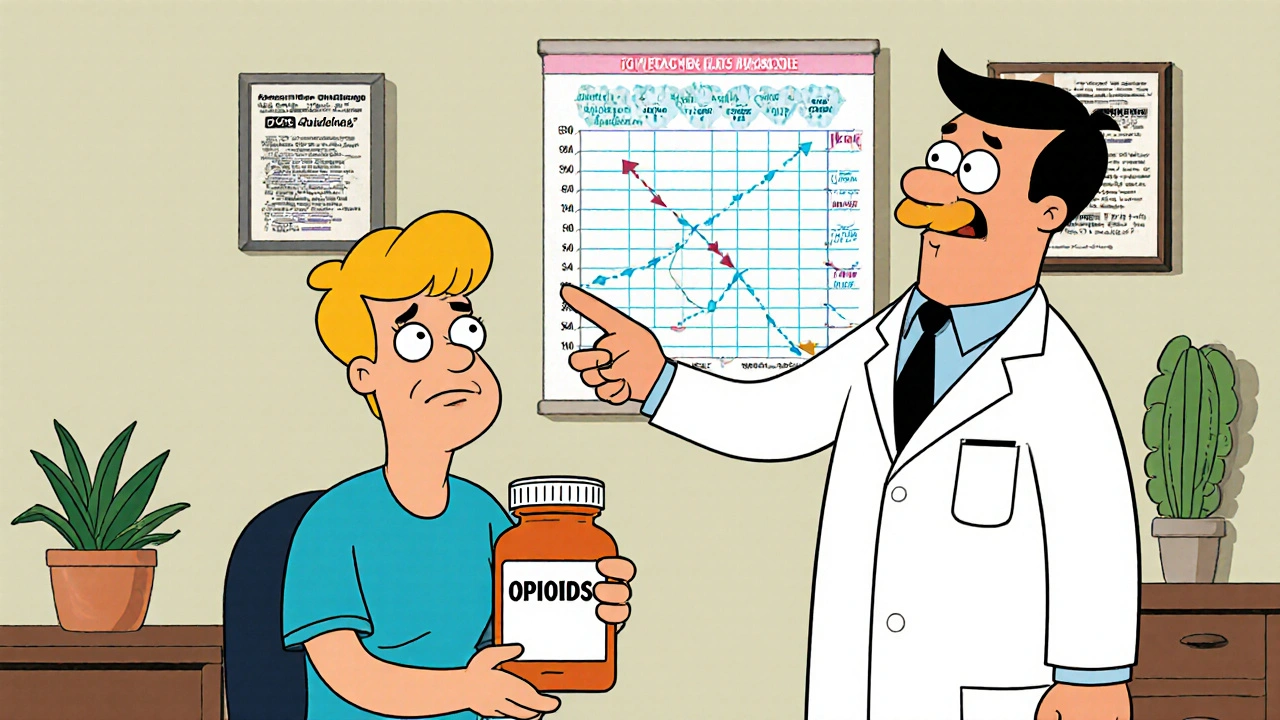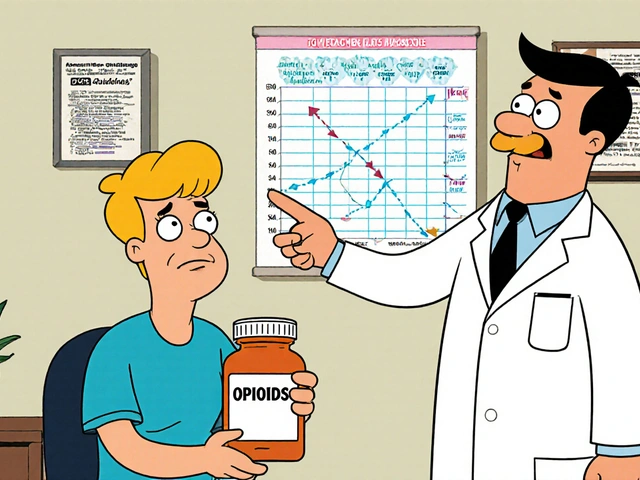Opioid Tapering Calculator
How to Use This Tool
Enter your current opioid dose in MME (Morphine Milligram Equivalents), choose your desired taper percentage, and select the time period for reduction. This calculator will show you a safe tapering schedule based on CDC guidelines.
Your Tapering Plan
Daily reduction: 0 MME
Estimated duration: 0 weeks
Start date: Today
Estimated end date: Today
Safety Considerations
When to Pause or Slow Down
If you experience any of these symptoms, contact your doctor immediately:
- Severe anxiety or panic attacks
- Uncontrollable nausea/vomiting
- Heart rate over 100 BPM
- Difficulty breathing
- Severe depression or suicidal thoughts
Withdrawal Symptoms to Expect
Withdrawal symptoms vary by individual, but common symptoms include:
- 82% experience anxiety
- 76% experience insomnia
- 68% experience muscle aches
- 59% experience nausea, vomiting, and diarrhea
These symptoms typically peak between days 3-7 and fade within 2-4 weeks.
Why Tapering Opioids Isn’t Just About Stopping
Stopping opioids cold turkey isn’t just risky-it’s dangerous. Between 2012 and 2017, the FDA recorded over 100 cases of severe harm from sudden opioid discontinuation, including suicide attempts, uncontrolled pain, and life-threatening withdrawal. If you’ve been on opioids for more than a few weeks, your body has adapted. That doesn’t mean you’re addicted. It means you’re physically dependent. And that’s something you manage, not ignore.
The goal of tapering isn’t to make you pain-free overnight. It’s to help you feel better over time-less drowsy, less constipated, more alert, and more in control. Studies show that when patients taper slowly with their doctor’s support, their pain scores drop by an average of 1.2 points on a 10-point scale, and their ability to move, sleep, and function improves significantly.
When Is Tapering the Right Move?
Not everyone on opioids needs to taper. But if any of these apply to you, it’s time to talk to your doctor:
- Your pain hasn’t improved in months, even at higher doses
- You’re experiencing side effects like dizziness, confusion, or severe constipation
- You’ve had an overdose or near-overdose
- You’re taking opioids with benzodiazepines or alcohol
- You’re refilling prescriptions early or losing pills
- Your mental health has worsened-increased anxiety, depression, or suicidal thoughts
The CDC’s 2022 guidelines make it clear: if opioids aren’t helping you live better, they’re hurting you. That’s when tapering becomes a health priority, not a punishment.
How Fast Should You Taper? Slow Is Safer
There’s no one-size-fits-all speed. But here’s what the evidence says: slow tapering saves lives.
Experts agree on these general ranges:
- Slow taper: Reduce by 10-25% every 1-3 weeks
- Fast taper: Reduce by 20-25% every few days to a week
Here’s the catch: fast tapers increase your risk of overdose by 68% and suicide attempt by 78%, according to a 2021 study in Annals of Internal Medicine. That’s not a small risk. It’s a red flag.
Patients on high doses (>90 morphine milligram equivalents, or MME, daily) or with mental health conditions often need even slower reductions-sometimes as little as 5-10% per month. The Oregon Health Authority recommends this for anyone above 120 MME. Your doctor should never push you faster than you’re comfortable with.
A 2022 survey of 1,200 people tapering opioids found that 63% preferred a 10% monthly reduction. Those who went slow had 32% higher adherence. That means they stuck with the plan-and stayed safer.

What to Expect During Withdrawal (And How to Handle It)
Withdrawal isn’t the same for everyone. About 35% of people on long-term opioids experience moderate to severe symptoms. The most common ones:
- Anxiety (82% of affected patients)
- Insomnia (76%)
- Muscle aches and cramps (68%)
- Nausea, vomiting, diarrhea (59%)
- Sweating, chills, runny nose
These symptoms peak around days 3-7 and usually fade within 2-4 weeks. But they’re manageable. You don’t have to suffer through them alone.
Doctors often prescribe supportive meds to ease the ride:
- Clonidine (0.1-0.3 mg twice daily): Reduces sweating, anxiety, and rapid heartbeat
- Hydroxyzine (25-50 mg at bedtime): Helps with anxiety and sleep
- Loperamide (2-4 mg as needed): Controls diarrhea
- NSAIDs or acetaminophen: For muscle pain and inflammation
These aren’t opioids. They don’t cause dependence. They’re tools to help you get through the transition.
Your Safety Net: Naloxone and Written Agreements
Even if you’re not using opioids recreationally, you’re still at risk during tapering. The Substance Abuse and Mental Health Services Administration (SAMHSA) says 41% of overdose deaths during tapering happen in the first 30 days. That’s why they recommend everyone starting a taper be given naloxone-a life-saving drug that reverses opioid overdoses.
You don’t need to be using heroin to need naloxone. If you’re on more than 50 MME daily, take benzodiazepines, or have a history of overdose, you should have it on hand. Keep it with you. Teach someone close to you how to use it.
Also, get a written tapering plan. The Oregon guidelines show that 87% of successful tapers involved a signed agreement between patient and provider. This isn’t bureaucracy. It’s clarity. It lists your current dose, reduction schedule, emergency contacts, and what to do if symptoms get worse. It gives you power. And it protects your doctor from making rushed decisions.
What to Do If Tapering Feels Too Hard
It’s okay to pause. It’s okay to go slower. It’s okay to stop and try again later.
Many people feel pressured to finish the taper quickly-especially if they’ve been told they’re “overusing” opioids. But the CDC warns that between 2017 and 2020, 12% of primary care providers misapplied guidelines and abruptly cut off patients. At least 17 suicides were linked to those actions.
If you’re struggling:
- Ask for more time
- Request a referral to a pain specialist or addiction counselor
- Consider medication-assisted treatment with buprenorphine-it’s not replacing one opioid with another. It’s stabilizing your brain so you can heal
- Add non-drug therapies: physical therapy, cognitive behavioral therapy (CBT), or mindfulness training
A 2021 JAMA study found that patients who got integrated care-including therapy and physical rehab-cut their chance of taper failure in half. From 44% down to 19%.

Success Isn’t Always About Stopping Completely
Many people think the goal is to get off opioids entirely. But that’s not always realistic-or even necessary.
Research shows that 68% of successful tapering plans aim for functional improvement, not zero pills. Maybe you go from 60 MME to 20 MME. Maybe you switch from a long-acting pill to a short-acting one you take only when you really need it. Maybe you stop opioids altogether but keep a low dose of gabapentin or an NSAID for flare-ups.
That’s not failure. That’s progress.
The real win? Being able to sleep through the night. Walking to the mailbox without help. Playing with your grandkids without feeling foggy. Those are the outcomes that matter.
What’s Changed Since 2022
The rules have tightened. In January 2024, the DEA made it mandatory for all licensed prescribers in the U.S. to complete 8 hours of continuing education on opioid tapering. That means your doctor should now know the latest guidelines, the risks of rapid tapers, and how to support patients properly.
And the CDC’s 2022 update made it crystal clear: tapering must be personalized. No set schedule. No arbitrary caps. No rushing. It’s about your body, your pain, your life.
If your doctor says, “You’re on too much, so we’re cutting you in half next week,” walk out. That’s not care. That’s negligence.
What You Can Do Today
- Write down your current opioid dose and how long you’ve been taking it
- Track your pain levels and side effects for a week
- Make a list of what you want to improve: sleep? energy? mood? mobility?
- Ask your doctor: “Can we make a slow, agreed-upon tapering plan?”
- Request naloxone if you’re on over 50 MME daily
- Ask about referrals to physical therapy or counseling
You’re not weak for needing help. You’re smart for seeking it.



Peter Aultman
November 7, 2025 AT 21:12Doctors need to stop treating this like a checklist. Every body reacts different.
Dilip Patel
November 9, 2025 AT 06:43Brittany C
November 10, 2025 AT 09:42Sean Evans
November 11, 2025 AT 19:30kshitij pandey
November 12, 2025 AT 11:43